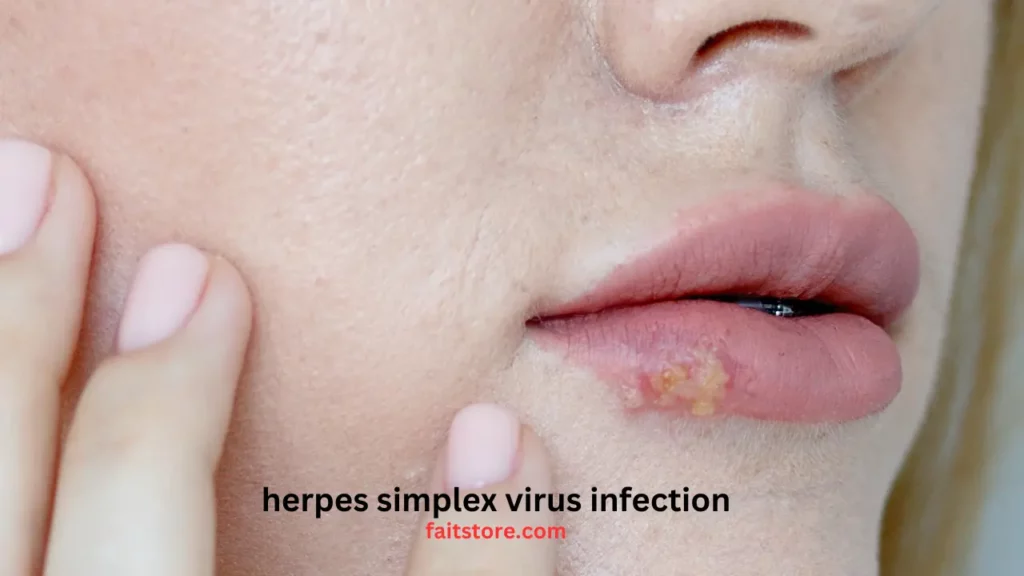Herpes Simplex Virus Infection: Symptoms, Causes, Treatment, and Prevention
Herpes Simplex Virus Infection: Symptoms, Causes, Treatment, and Prevention
Herpes simplex virus (HSV) infection is a common viral infection caused by the herpes simplex virus. It is a contagious infection that can cause symptoms from mild to severe. This article will provide an overview of the symptoms, causes, treatment, and prevention of HSV infection. Herpes Simplex Virus Infection
Types of Herpes Simplex Virus
There are two main types of Herpes Simplex Virus (HSV): HSV-1 and HSV-2.
HSV-1 (Herpes Simplex Virus Type 1):
- HSV-1 is primarily associated with oral herpes. It is commonly transmitted through direct contact with an infected person, such as through kissing, sharing utensils, or coming into contact with oral secretions. HSV-1 causes cold sores or fever blisters, characterized by painful sores or blisters around the mouth and on the face. However, HSV-1 can also cause genital herpes through oral-genital contact. It is important to note that HSV-1 can be transmitted even when no visible sores are present. Herpes simplex virus infection

HSV-2 (Herpes Simplex Virus Type 2):
- HSV-2 is primarily associated with genital herpes. It is usually transmitted through sexual contact, including vaginal, anal, or oral sex. Genital herpes is characterized by sores, blisters, or ulcers in the genital area. Like HSV-1, HSV-2 can also be transmitted with no visible symptoms or sores. It is important to practice safe sex and take necessary precautions to reduce the risk of transmission.
It’s worth mentioning that while HSV-1 is traditionally associated with oral herpes and HSV-2 with genital herpes, either type can cause infection in either location. In recent years, there has been an increase in genital HSV-1 infections due to changing sexual practices.
It’s important to note that both types of HSV are lifelong infections, and individuals with the virus can still transmit it to others, even when asymptomatic. Proper diagnosis, testing, and medical advice are essential for managing and treating herpes infections.
How is Herpes Simplex Virus Infection Transmitted?
Herpes Simplex Virus (HSV) can be transmitted through various modes of contact. Here are the primary methods of HSV transmission:
- Direct Contact: HSV is mainly transmitted through direct contact with an infected person who is shedding the virus. This can occur through kissing, oral-genital contact, vaginal or anal intercourse, or touching an active herpes sore or blister. The virus can enter the body through breaks in the skin or mucous membranes.
- Asymptomatic Shedding: Even when an infected individual has no visible sores or symptoms, they can still shed the virus and transmit it to others. This is known as asymptomatic shedding. It is estimated that a significant portion of HSV transmissions occurs during asymptomatic shedding.
- Sexual Contact: HSV-2, in particular, is primarily transmitted through sexual contact, including vaginal, anal, or oral sex. Genital herpes is commonly spread through sexual activities involving the infected genital area. However, it’s important to note that HSV-1, typically associated with oral herpes, can also be transmitted to the genital area through oral-genital contact.
- Vertical Transmission: Pregnant women with genital herpes can pass the virus to their newborn during childbirth. This is known as vertical transmission. In such cases, precautions are taken to minimize the risk of transmission, such as antiviral medication and, in some cases, cesarean delivery.
- Indirect Transmission: Although less common, HSV can be indirectly transmitted through contaminated objects or surfaces. For example, sharing personal items like towels, razors, or utensils with an infected person can potentially transmit the virus if there is active shedding and the virus comes into direct contact with a break in the skin. Herpes simplex virus infection

Comments
Post a Comment